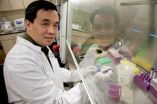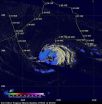(Press-News.org) Fishing hooks aren't the only hooks found in east-central Mexican waters.
A new species of freshwater fish described by a North Carolina State University researcher has several interesting – and perhaps cringe-inducing – characteristics, including a series of four hooks on the male genitalia.
Females of the new species – the llanos mosquitofish, or Gambusia quadruncus – also have distinguishing characteristics, including a colorful anal spot.
A paper describing the new species, which lives in a diversity hotspot and seemingly branched off from its closest relative more than one million years ago, appears in the Journal of Fish Biology.
Dr. Brian Langerhans, assistant professor of biology at NC State and the lead author of the paper, says that these interesting characteristics may play important roles in mating control and success.
While more research is needed, Langerhans says that four-hooked genitalia on males can serve a purpose when females attempt to block or restrict mating attempts.
"Typically, reproduction is more costly in females, so females favor ways of reducing mating with 'lower quality' males," Langerhans says, "but reproduction is cheap in males and so selection favors ways of mating with as many females as possible. In Gambusia, some females, including G. quadruncus, have evolved modifications that appear to function as a blocking device – essentially a big ball of tissue blocking most of the genital pore – restricting entry of the male's gonopodial tip. Thus, the female would have to behaviorally allow the male to mate or the male would have to evolve a counter response to avoid this problem."
The four-hooked genitalia could be that counter-response, Langerhans says.
"Having four hooks on the gonopodium may provide a means of overcoming female resistance, latching on to the gonopore and transferring sperm in a manner that facilitates effective sperm transfer. Or it may serve to stimulate the female in a manner that causes responses in the female that facilitate effective sperm transfer," Langerhans says.
Somewhat similarly, the colorful anal spot on females appears to serve as a signal that only certain males are desired for mating.
"The differing, species-specific female anal spots appear to influence male mating behavior by signaling the location of the gonopore to the male, sometimes indicating the reproductive status of the female, and distinguishing fish of their own species from fish of other species to reduce costly cross-breeding, which can result in fish with reduced fitness," Langerhans says. "So it may be that G. quadruncus evolved different anal spots to help reduce interspecies matings and possible formation of hybrids."
INFORMATION:
Note to editors: An abstract of the paper follows.
Gambusia quadruncus (Cyprinodontiformes: Poeciliidae): A new species of mosquitofish from east-central Mexico
Authors: Brian Langerhans, North Carolina State University; et al
Published: Online September 2012, in Journal of Fish Biology
Abstract: Gambusia quadruncus n. sp., the llanos mosquitofish, is described from east-central Mexico. The region inhabited by the species represents a hotspot of diversity of Gambusia, and G. quadruncus sometimes coexists with at least three congeners. The species differs from its closest relative, Gambusia affinis, in several characteristics with plausible effects on reproductive isolation, e.g. body size, body and fin morphology, male genital morphology (distal tip of gonopodium) and female anal spot morphology (colouration near the urogenital sinus). Moreover, combined analysis of mitochondrial and nuclear gene sequence data (c. 2158 total base pairs) indicates reciprocal monophyly of G. quadruncus and its sister species G. affinis, with levels of genetic divergence suggesting the two species diverged from one another over a million years ago. The origin of G. quadruncus may reflect a vicariant event associated with Pliocene orogenesis in the Tamaulipas Arch and a frontal section of the Sierra Madre Oriental (Lleran Mesas). Gambusia quadruncus inhabits a variety of freshwater habitats across several river drainages, with its range spanning at least 350 km from north to south, covering over 25 000 km2. A key to aid identification of the species is provided.
New fish species offers literal take on 'hooking up'
2012-09-28
ELSE PRESS RELEASES FROM THIS DATE:
Deadly complication of stem cell transplants reduced in mice
2012-09-28
Studying leukemia in mice, researchers at Washington University School of Medicine in St. Louis have reduced a life-threatening complication of stem cell transplants, the only curative treatment when leukemia returns.
About 50 percent of leukemia patients who receive stem cells from another person develop graft-versus-host disease, a condition where donor immune cells attack the patient's own body. The main organs affected are the skin, liver and gut. Now, the scientists have shown they can redirect donor immune cells away from these vital organs. Steering immune cells ...
Nickelblock: An element's love-hate relationship with battery electrodes
2012-09-28
RICHLAND, Wash. -- Anyone who owns an electronic device knows that lithium ion batteries could work better and last longer. Now, scientists examining battery materials on the nano-scale reveal how nickel forms a physical barrier that impedes the shuttling of lithium ions in the electrode, reducing how fast the materials charge and discharge. Published last week in Nano Letters, the research also suggests a way to improve the materials.
The researchers, led by the Department of Energy's Pacific Northwest National Laboratory's Chongmin Wang, created high-resolution 3D ...
Measuring the universe's 'exit door'
2012-09-28
CAMBRIDGE, MA -- The point of no return: In astronomy, it's known as a black hole — a region in space where the pull of gravity is so strong that nothing, not even light, can escape. Black holes that can be billions of times more massive than our sun may reside at the heart of most galaxies. Such supermassive black holes are so powerful that activity at their boundaries can ripple throughout their host galaxies.
Now, an international team, led by researchers at MIT's Haystack Observatory, has for the first time measured the radius of a black hole at the center of a distant ...
World's first glimpse of a black hole 'launchpad'
2012-09-28
A strange thing about black holes: they shine.
The current issue of Science Express features a paper by the Event Horizon telescope team – a collaboration that includes Avery Broderick, Associate Faculty at Perimeter Institute – that may shed light on the origin of the bright jets given off by some black holes. In a world first, the team has been able to look at a distant black hole and find out where its jets are launched from: the "launchpad".
Many galaxies, including our own Milky Way, have a huge black hole lurking at their cores. In about 10 percent of such galaxies, ...
Newspaper sales suffer due to lack of stimulating content
2012-09-28
Los Angeles, CA (September 27, 2012) – Since the newspaper industry started to experience a major decrease in readership in recent years, many people have deemed the internet and other forms of new media as the culprits. However, a recent study published in the Journalism & Mass Communication Quarterly, a SAGE Journal, finds that sales are down because readers need more engaging and stimulating content.
Study authors Rachel Davis Mersey, Edward C. Malthouse, and Bobby J. Calder suggested that it is crucial for journalists and practitioners to focus their efforts on creating ...
Researchers investigate aggression among kindergartners
2012-09-28
UNIVERSITY PARK, Pa. -- Not all aggressive children are aggressive for the same reasons, according to Penn State researchers, who found that some kindergartners who are aggressive show low verbal abilities while others are more easily physiologically aroused. The findings suggest that different types of treatments may be needed to help kids with different underlying causes for problem behavior.
"Aggressive responses to being frustrated are a normal part of early childhood, but children are increasingly expected to manage their emotions and control their behavior when ...
Liver cells, insulin-producing cells, thymus can be grown in lymph nodes, Pitt team finds
2012-09-28
PITTSBURGH, Sept. 27, 2012 – Lymph nodes can provide a suitable home for a variety of cells and tissues from other organs, suggesting that a cell-based alternative to whole organ transplantation might one day be feasible, according to researchers at the University of Pittsburgh School of Medicine and its McGowan Institute for Regenerative Medicine. In a report recently published online in Nature Biotechnology, the research team showed for the first time that liver cells, thymus tissue and insulin-producing pancreatic islet cells, in an animal model, can thrive in lymph ...
Genetic sleuthing uncovers deadly new virus in Africa
2012-09-28
An isolated outbreak of a deadly disease known as acute hemorrhagic fever, which killed two people and left one gravely ill in the Democratic Republic of Congo in the summer of 2009, was probably caused by a novel virus scientists have never seen before.
Described this week in the open-access journal PLoS Pathogens, the new microbe has been named Bas-Congo virus (BASV) after the province in the southwest corner of the Congo where the three people lived.
It was discovered by an international research consortium that included the University of California, San Francisco ...
NASA sees light rainfall in Tropical Storm Nadine
2012-09-28
NASA's TRMM satellite noticed that the intensity of rainfall in Tropical Storm Nadine has diminished today, Sept. 27.
The Tropical Rainfall Measuring Mission or TRMM satellite passed over Tropical Storm Nadine on Sept. 27 at 0739 UTC (4:39 a.m. EDT) and at 0917 UTC (5:17 a.m. EDT). At NASA's Goddard Space Flight Center in Greenbelt, Md., several TRMM instruments were used to create a full picture of Nadine's weakened rainfall. The image was created with an enhanced infrared image from TRMM's Visible and InfraRed Scanner (VIRS) overlaid with rainfall data derived from ...
Simulations uncover 'flashy' secrets of merging black holes
2012-09-28
VIDEO:
Supercomputer models of merging black holes reveal properties that are crucial to understanding future detections of gravitational waves. This movie follows two orbiting black holes and their accretion disk during...
Click here for more information.
According to Einstein, whenever massive objects interact, they produce gravitational waves -- distortions in the very fabric of space and time -- that ripple outward across the universe at the speed of light. While astronomers ...




